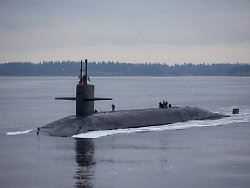Monday 14 June 2021
Researchers see arms race
The number of operational nuclear weapons is increasing
When it comes to the number of nuclear weapons in the world, researchers rely on estimates. Nevertheless, they do not take the fact that their stocks are decreasing as a good sign: warheads are being decommissioned because stocks are currently being modernized. China is now number three in nuclear weapons.
Peace researchers see signs of a worrying turnaround in global nuclear stocks. The total number of nuclear warheads continued to decline, as the annual report of the Stockholm peace research institute Sipri shows. However, more nuclear weapons are operational than there were a year ago. The reduction in deployable warheads appears to have stalled, the report said. At the same time, extensive modernization programs were running.
“If you just look at the total number of nuclear weapons, the disarmament picture looks much better than it actually is,” said Sipri expert Matt Korda. The number is only falling because the two largest nuclear powers, the USA and Russia, are decommissioning old warheads. “And that’s where the good news ends. Both the US and Russia, as well as practically every other nuclear-armed state, are in the middle of expensive and extensive nuclear modernization campaigns that end with growing numbers of nuclear weapons in the military camps.”
In total, the world’s nine nuclear powers still had an estimated 13,080 nuclear weapons at the beginning of 2021 – 320 fewer than in the previous year and less than a fifth of what was in the arsenals at the height of the Cold War in the mid-1980s. The USA still has 5,550 atomic explosives today. According to the Sipri experts, Russia still has 6255. However, the researchers rate another number as worrying: that of nuclear warheads that are already mounted on missiles or are on active bases. These are considered ready for use by Sipri.
2000 warheads in maximum operational readiness
Their number rose year-on-year from 3720 to 3825. The USA and Russia added around 50 each. According to Sipri, around 2,000 of these warheads are being kept in full operational readiness – almost all of them by Russia and the USA. While other countries waited impatiently for progress on nuclear disarmament, all nuclear powers invested in the long-term future of their nuclear arsenals, Korda said. This will make the gap even wider.
The trend to reduce the numbers and give the nuclear arsenals a smaller role has now presumably stopped – and in some cases even reversed. US President Joe Biden and Kremlin chief Vladimir Putin agreed on an extension shortly before the New Start nuclear disarmament treaty expired in February. This was a relief, according to Sipri expert Hans M. Kristensen. However, the prospects for additional bilateral controls between the two nuclear superpowers are slim. “Both Russia and the US seem to be attaching increasing importance to nuclear weapons in their national security strategies.”
Classic arms race
Sipri expert Korda sees several interlocking factors behind this development. The modernization courses would be driven, among other things, by the current rivalries between the nuclear powers. “We are currently seeing very classic behavior in the arms race.” The nuclear-armed states did not appear to view disarmament as a matter of urgency. It remains to be seen whether the situation will change under Biden.
Washington and Moscow have more than 90 percent of all nuclear weapons at their disposal almost three decades after the end of the Cold War. But even behind this, something is happening, according to the Sipri annual report: All seven other nuclear powers have developed or deployed new weapon systems or have announced corresponding intentions. China is therefore in the middle of a major modernization and expansion of its nuclear arsenal.
China is now in third place
Beijing is now establishing itself in third place among the nuclear powers with an estimated 350 nuclear weapons, followed by France (290) and Great Britain (225). In contrast to the other four UN veto powers, China is not one of the countries with operational warheads at Sipri. Pakistan (165) and India (156) are also gaining ground, Israel remains with an estimated 90 nuclear weapons.
In addition, there is North Korea’s arsenal, the number of which is now estimated at 40 to 50, but is not included in the global total due to uncertainties. For Sipri, however, one thing is clear: “North Korea continues to prioritize its military nuclear program as a central element of its national security strategy.” Last year, Pyongyang did not test any nuclear or long-range missiles in flight, but promoted the development of missiles and the production of fissile material.
Sipri gets its data from public sources. Korda pointed out that in the years of Biden’s predecessor Donald Trump’s administration, it had become increasingly difficult to gather information on the status of nuclear weapons in the world. “The issue of nuclear transparency is a problem,” he said.
.
